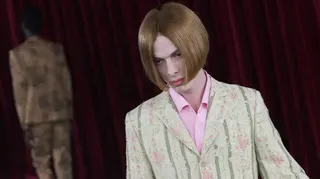June 4, 2009
Matt Tyrnauer Gets Very Valentino
Tony Phillips READ TIME: 17 MIN.
I'm sorry," Vanity Fair scribe Matt Tyrnauer apologizes for the metal-on-metal squeal that's either the M-103 or Manhattan's latest terror siege, "I'm on Lexington." The physical shift this downtown type has made to an advertising main drag adjacency is a figurative one for Tyrnauer as well since he spent the last three years of his life seven blocks west on Fashion Avenue.
His documentary, Valentino: The Last Emperor, found him trailing the out, Italian fashion icon down Rome, Paris and London's equivalents to Seventh Avenue for two years as well. There was also a year spent holed up in the editing suite. But these days, Tyrnauer's got a movie to sell: Hello, Lex.
The out Angeleno grew up a Hollywood insider. Dad was a show runner for the likes of "Columbo" and "Murder, She Wrote." But in true Bret Easton Ellis style, Tyrnauer ditched Babylon for the go-go 80s New York, where he took up with its resident Nero: Graydon Carter. Tyrnauer worked on Carter's fabled publication Spy and then made the leap with his mentor when Carter took over Vanity Fair.
Tyrnauer spent 17 years at that title, where he penned memorable interviews of the above mentioned Easton Ellis and Martha Stewart, both before and after the fall, as well as that landmark in gay journalism: his Siegfried and Roy interview, that helped carve a place of pride for that publication on any Fire Island summer house coffee table.
In 2004, Tyrnauer profiled Italian the sublime, at times gloriously tacky, fashion designer Valentino Garavani and the two got on like a house on fire. It was shortly thereafter that Tyrnauer decided to shelf celebrity journalism, dust off his Wesleyan film degree and take up with both Valentino and his 50-year beau and business partner Giancarlo Giammetti full-time.
The results are probably best summed up by fashion doyenne Polly Mellen in the last great fashion documentary, the Isaac Mizrahi chronicle "Unzipped." "This erases everything," Mellen was reported to crow after a preview of Mizrahi's latest collection, "You just made fashion history." If that's true, then Tyrnauer has just rewritten it.
A visual subject
Tony Phillips: If the glossy magazine feature goes anywhere after publication, it's usually to a publishing house where it's blown out into a book. What made you decide to go the cinema verite route with Mr. Garavani?
Matt Tyrnauer: Well, a book and an article are relatively similar in that they're in the same medium, but I thought it would be really interesting to try and do this in a different form because Valentino is such a visual subject. And I have a degree in film that I never really put to use. I'd been writing about figures like this that are very larger than life and have these extraordinary careers. None is more colorful than Valentino. He's a great, iconic presence so I thought I would try my hand in a new medium and he gave me the right subject.
Tony Phillips: Your Siegfried and Roy portrait comes pretty close in terms of color.
Matt Tyrnauer: Well, I think there are some similarities between the characters.
Tony Phillips: Absolutely.
Matt Tyrnauer: Both stories are about enduring relationships that happen to be about two gay men who have these kinds of interlocking lives and careers and are very mutually dependant on each other. They are extraordinarily rich and famous, at the very tops of their professions, and, for me, they're both the stories of a marriage. This is what the Valentino story is, really, the story of a partnership and a marriage. Siegfried and Roy is exactly the same thing on that level.
Tony Phillips: It's interesting to insert yourself into a marriage, in any sort of context, but particularly into a 50-year relationship. What was that dynamic like?
Matt Tyrnauer: Well, you know, as a journalist or a documentarian, you are an interloper. You are by definition intruding. But you raise a good point; the dynamic between all three of us was very interesting. Here you have this 50-year - I call it a "mega-marriage" because it spans generations - gay partnership that's just incredible because it defies all odds. I became present, and when you stick around with a camera long enough, the characters start to talk to the camera and tell the camera things that they can't tell each other. In any marriage, as close as you are, there are things you can never quite bring yourself to tell your loved one. And I think this documentary camera became a way of doing that. I began to see it happen. I think the most noticeable example of that is near the end of the film when Giancarlo decides to tell Valentino that he looks too tan.
Tony Phillips: I love that scene.
Matt Tyrnauer: But he had every opportunity over 50 years to say that.
Upper photo :: Valentino in a still from "Valentino: The Last Emperor."
Lower photo :: journalist and filmmaker Matt Tyrnauer
Crossing boundaries?
Tony Phillips: So getting back to this interloper idea, I get it, but aren't you also the cute young American entering what may be at this point a familiar, if not somewhat creaky, relationship. I guess what I'm asking is isn't this m?nage a tois plus camera?
Matt Tyrnauer: The relationship didn't cross boundaries of intimacy in a carnal sense. We got to know each other very well. I was let into their lives. I was eating dinner at their table. And on one occasion I "lived-in" in Gstaad, simply because there were no hotel rooms available that night so I was brought into the very cosseted world of breakfast in bed and the scented laundry that comes back five times a day.
Tony Phillips: I didn't mean to imply that you acted on it, but it seems silly to pretend that tension isn't there. I mean, isn't that the dynamic? And further, what's wrong with that? I find this ethical line between interviewer and subject to be bullshit. I mean, look at that film Elton John's boy toy made about him, or a film that yours is being compared to a lot, "Unzipped." Weren't Isaac and Doug fucking for at least half that picture? And, in what seems even more of a breach, breaking up for the other half? Why not be intimate with a subject if the goal is, with all apologies to Lifetime, an intimate portrait?
Matt Tyrnauer: I see what you're getting at, but I do think you need to be very careful. You cannot, especially for the kind of journalism Vanity Fair does that I have practiced for a while, it's access journalism. You must not become or aspire to become a part of your subjects' lives. You have to remain separate. The minute you start to drink the Kool-Aid or try to become a part of the party, separate from your journalistic identity, I think it becomes impossible for you to do the work. You can't be objective anymore and you start to have too many associations. You get a kind of form of journalistic Stockholm syndrome.
Tony Phillips: Okay, I'm not trying to belabor the point, but even in everything I've read about this film, you talk about your relationship with Valentino in terms of marriage. I just read something where you said that after the 2004 feature, Valentino "didn't want a divorce." I don't think you were talking about Giancarlo there.
Mat Tyrnauer: Look, first of all those two have never been so open with anyone, certainly a journalist. During the Vanity Fair story they really sort of opened up about their relationship. They had never talked about that before. This was breaking news, in a certain way. I think it was time for them to do it. You have to realize, they lived with their mothers until their mothers died.
Tony Phillips: Ah, one of my favorite Italian traditions: The Mamoni!
Matt Tyrnauer: Oh, yeah, yeah, but they had a very Catholic upbringing.
Tony Phillips: So up until that Vanity Fair interview, were they passing? Because those scenes of them strolling arm-in-arm, what do they call that in Italy, the passeggiata, that evening stroll? That's another major Italian tradition, and one that throws me for a loop every time I'm there. When you first see that, it's like, wow, look at how gay everyone is, they're all holding hands, but then you slowly realize that no one there is gay, at least not openly.
Matt Tyrnauer: The Italian culture is very layered and very kind of brilliant and mysterious and the forbidden is permitted, but also the thing about Italy is everybody knows the score. Everybody. So there are things in Italian culture that just exist sub rosa and they're just allowed to exist, even though they're mortal sins and they're against convention and they are repellent to the accepted norms of society. So no, they weren't passing. Everyone knows, but to talk about it in print is a different thing. And I think they were ready to do it. It's very cathartic. And I think the film's very cathartic because you have a couple things going on here. You have a partnership that is almost preternaturally enduring and close. It's touching in a certain way, but there's also a man that's lived in the shadow of another man who is world famous and he is emerging for the first time.
And then there's the issue of homosexuality and what that means in terms of being someone's life partner. That's what we're dealing with here, and especially this year in this country, when we're grappling with gay marriage and Proposition 8, they're a very interesting, living example of that. But just to get back to the dynamic, why they chose to open up to me, I really don't know. I got them. I'm really interested in enduring friendships between gay men and I was really fascinated with theirs, but I was fascinated with Siegfried and Roy as well. That kind of thing really interests me and I think they picked up on that. Not every journalist that goes to see them is gay, so I think they were comfortable with me because of that. And also, I'm not a fashion journalist either, so I didn't know every collection or the good collections from the bad ones. I had no idea. That also made them much more comfortable with me.
Photo :: Valentino Garavani and Giancarlo Giammetti seen in a still from "Valentino: The Last Emperor."
Valentino’s retirement?
Tony Phillips: So your shooting schedule seems to be the inverse of most documentaries where you shot for two years and then edited for one. 250 hours of footage is a hell of a lot of tape to juggle in just a year. How did you do that?
Matt Tyrnauer: We actually did it in less than a year, to be honest with you. It was really fast for what we were trying to do. We were cutting a little bit as we went along so I kind of had an idea. I knew that I wanted the relationship to be at the center and then we had this party and the retirement came upon us. It was just a natural third act so we knew what our ending was. I think that was very helpful.
Tony Phillips: I'm very much with you on the whole cinema verite thing. It's the way I work as well, but it is sort of a gamble. You really hope that third act presents itself when you need it to, but you don't always know that's going to happen. What was that spontaneous thing for you in the film?
Matt Tyrnauer: It really was what we're talking about.
Tony Phillips: Valentino's retirement?
Matt Tyrnauer: Well, it's not really the retirement, actually. It's the kind of living commemoration of the career. One of my favorite movies is "81?2" and there are so many parallels because it's Rome and Valentino is such a Felliniesque subject, but at the end of "81?2" there's a resolution where all the character's from Guido's life come together and they sort of parade down these stairs on the set of the movie that he can't finish. That for me was really an "Oh, my God!" moment because I love that ending of "81?2" -- I kind of tear up whenever I see it -- and what was happening was everyone from Valentino's life was converging on Rome and they're all these perceptions from these people from his history and he has to kind of edit his career in front of the camera for the exhibition so all of these things were really amazing strokes of luck.
Tony Phillips: There's a really interesting moment in that parade where you've got Karl Lagerfeld and Elton John and a whole bunch of other notables in a villa and you look around and think, wow, all of these people have had this documentary treatment. To me, it seems like documentaries are almost the modern day equivalent to those fabulous silk-screened portraits of himself by Warhol that Valentino keeps on his yacht.
Matt Tyrnauer: Wow, well this is the first time that one's been asked. I think it makes sense in a certain way. I think you might be onto something. You know, reality TV is just as big if not bigger in Italy as it is in the United States. People live their lives in front of the camera. This Warhol prophecy has come true, writ large, but it makes it much more acceptable to have a camera around. But this is also different. This isn't reality television. This is something that's very refined and polished, but I think there might be some kind of collective unconscious involved regarding what you're brining up. I don't think Valentino was really thinking of that because when we started no one knew about the Lagerfeld documentary, but I think something was definitely in the air.
And, of course, independent film exploded over the last ten years and documentary is such a big part of that. And look, when you're a Lagerfeld, an Elton John, a Valentino, you're more famous than famous. It's almost unbelievable. A lot of times when you're that famous and you've been that successful, and frankly, that lucky, you can't believe it. You need a witness. I think that's a lot of what this is about. They tell their story frequently because when you're super-famous you spend a lot of time telling your story and it gets set. I know for Valentino, even though he bristled at having the camera there a lot and was very impatient and he's a control freak - he'll admit that he's a perfectionist and has big explosions - he found it quite interesting that someone was taking the time to put the story on film.
Tony Phillips: So how much of a Xanax moment was it when he had his explosions? Like when he quit the film, for example.
Matt Tyrnauer: Very. Because everyone around him is so conditioned to respond to Valentino having a category four disturbance, everyone scatters and hides in the closet, as it were.
Tony Phillips: Even the pugs.
Matt Tyrnauer: But we were different because we didn't work for him. We were very good people to blame because we weren't on the payroll and we were the intruder. We were trampling all over everything. It's like that scene in "Mommie Dearest" where she moves the plant and there's that dirt ring. She has a meltdown and says she's not mad at the maid, she's mad at the dirt. Valentino was frequently mad at the dirt. We would experience these moments where smoke was coming out of his ears and he's screaming at the camera and the cameraman, in this case it was Frederic Tchang, was ordered not to stop filming, which is very hard to do in that situation, but we did it and I kept it in the film because I wanted to show what it was like. I think it makes him much more human.
Tony Phillips: So getting back to Valentino's pugs, I noticed six in the credits, but only remember five in the film.
Matt Tyrnauer: One doesn't travel. She's the mother. She's too old.
Tony Phillips: That old W.C. Fields' rule about children and animals...
Matt Tyrnauer: Well, I'm a big fan of the breed so they were great. The shot on the airplane where they're all sitting in a row, they held that position for their big shot so I have to give them high marks.
Tony Phillips: Okay, so another ridiculous question, with all those gorgeous clothes all over the place, were you ever tempted to stray from the gender binary?
Matt Tyrnauer: Um, I think that might be a different phase of psyche that I haven't arrived at yet. I've never been tempted to wear a dress, even a couture dress.
Tony Phillips: Well, sure, and most of it's sized to a fit model, but when he hauled out those muumuus for Andre Leon Talley, Christ! How did you not just call cut and jump into one of those things?
Matt Tyrnauer: No, I'm standing by the answer I just gave you. They're amazing to see. And you do just want to touch them. A woman who wore Valentino told me that you can wear them inside out because it's so perfectly made. The stitching inside doesn't look any less neat then when the dress is right side around.
Photo :: Valentino Garavani and models seen in a still from "Valentino: The Last Emperor."
A "Dolce Vita" moment
Tony Phillips: Wow, that's one fucked up Real Housewife running around with her Valentino on inside out. So, Matt, getting back to Fellini and "81?2", you're kind of fortunate to have had your own "Dolce Vita" moment in New York working for Spy. What was that like?
Matt Tyrnauer: Oh, it was amazing. Even as Spy was ending, you had the sense that it was a golden age. I mean, just look what happened. Graydon Carter and Kurt Andersen, what they did at Spy changed every magazine in the country, if not the world. That was the blueprint for the future.
Tony Phillips: I know they say if you can remember it, you weren't really there, but do you have any specific memories of New York at that time? It's definitely not the same New York we're in now.
Matt Tyrnauer: Yeah, but it might be coming back. I've always lived downtown. And I remember walking home down Fifth Avenue and getting to Washington Square and starting to hear crunching under my feet. It was all these crack vials.
Tony Phillips: Fabulous! I miss that New York.
Matt Tyrnauer: Those days are gone, but I like New York clean, actually. I hoping we don't go back to the crack vials on the street.
Tony Phillips: I'm with Fran Lebowitz. I never felt imperiled in crack vial New York.
Matt Tyrnauer: Well, no, because it's exciting when you're 19 or 20. You want a bit of edge.
Tony Phillips: So you've already seen this film through some pretty swank premieres, from Venice on down. What do you have up your sleeve for the New York premiere?
Matt Tyrnauer: It's been one amazing thing after another. You know, Valentino and Giancarlo don't show up at B-list events so we've had to kind of step it up for them. New York is MoMA hosting the premiere and then there's a huge dinner for the cr?me of the Upper East Side at the Plaza afterwards. And then Andre Leon Talley and I are doing joint appearances together at the Film Forum over several nights. What else are we doing here? We're doing a press orgy, actually. We did Oprah. That just aired. We're doing Barbara Walters and Martha Stewart, all the icons, all the great ladies. And we're adding Charlie Rose for some testosterone.
Tony Phillips: I always see Charlie at The Four Seasons bar with his TV makeup still on so I don't know about testosterone, but Martha was another big get in your career as a journalist.
Matt Tyrnauer: Yeah, Martha was a before and after, but the big get was getting her when she was still under house arrest. That was the second interview. The first interview was when the empire was on the up swing, but I was the only one she let in when she was under house arrest.
Tony Phillips: So she just liked the first piece and decided to go with the devil she knew?
Matt Tyrnauer: I really like her and admire her. I think she's quite significant, actually, in the long view of things. She's a cultural interpreter. She's a mini Thomas Jefferson in a weird way. She's a renaissance woman and no one will ever do again what she did. And I think she sensed that I appreciated that. She was not happy with the second interview. She did not like it. I think she thought it was too direct. I wrote a lot about the prison experience. I drew her out on it and she didn't want to be drawn out, but I think the wonderful thing about Martha Stewart is she is very open when you're talking to her. She tells it like it is so she's actually an excellent interview.
Tony Phillips: Well, I think you are too, Matt. So just to wrap up here, in that third act of your film, especially in Rome when the models start flying Cirque du Soleil-style over the Temple of Venus, it really feels quite decadent. I know you shot this a while ago, but do you feel like such a display of conspicuous consumption is going to go over with economic gloom and doom everywhere?
Matt Tyrnauer: Well, I think the movie is a look at an era that is slipping away even as the cameras are rolling. I think it's wistful. I don't think it's necessary celebratory. It's a rather direct look that doesn't triumph excess so much as it shows you what it was and what it is. The audience can project onto that what it will become. And I also think, in times of hardship, people want to see visual examples of beauty and achievement and be inspired by that. The Great Depression was the golden age of Hollywood cinema. No one thought "Gone with the Wind" should be reframed to take place in Toronto. Busby Berkley was making these extraordinary lavish musicals and people wanted to go see that because it's aspirational, but this movie is not a celebration of gross excess in any way. It's a document.
Valentino: The Last Emperor is currently playing in New York at the Film Forum. It opens on March 27 at Chicago's Landmark Century; April 3 at San Francisco's Opera Plaza and Los Angeles's Laemmle Sunset 5.
Photo :: Valentino Garavani seen in a still from "Valentino: The Last Emperor."
Tony Phillips covers the arts for The Village Voice, Frontiers and The Advocate. He's also the proud parent of a new website: spookyelectricproductions.com.






